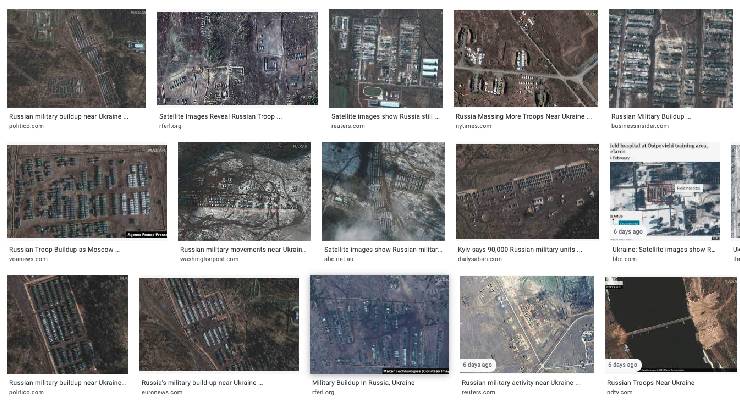
Satellite images of moving Russian troops. TikTok videos showing explosions in Ukraine. Filmed speeches from officials released via Telegram. Bird’s-eye live streams. Voices chattering over internet radio. An endless delivery of data from every perspective that can tell us exactly what is happening in the Russia-Ukraine crisis.
The traditional idea of the “fog of war”, and everything that happens in the lead-up to conflict, is a thing of the past. Technology killed it in the eight years since Russia’s annexation of Crimea.
Information that was once confined to militaries or governments is now cheaply or even freely available. Everyone — researchers, journalists, Joe Citizen with an internet connection — is now an investigator and analyst with the world’s information at their fingertips.
Perhaps the most significant change has been the increasing accessibility of precise and recent satellite imagery.
As discussed in the Lowy Institute’s The Interpreter, only superpowers could once afford the huge satellites needed to produce photographs that had the necessary resolution to detect objects like weaponry or troops. Now, there’s been an influx of hundreds of smaller satellites that maintain (or even improve) the resolutions previously available.
This means that any location in the world can be captured multiple times a day, even at night or while covered in clouds, at a much lower cost.
The disruption of this industry has allowed the world to track the movements of Russian troops in near real time that contradicted denials from the Kremlin.
News articles with images sourced from technology companies have allowed the press to reduce their reliance on information released by governments on their terms. Even the limits of commercially available imagery can be useful. Analysts have found that certain distortions in some kinds of satellite photographs are a tell-tale sign of military radar, according to The Economist.
The democratisation of satellite imagery has also coincided with the de facto global panopticon of smartphone cameras and rise of social networks. Videos and photographs of soldiers moving have been shared online which, when cross-referenced against other information like satellite photography, have provided more detail about what’s happening on the ground.
Eyes on evidence in Russia-Ukraine crisis
Loosely organised online networks of open source investigators scour social media for content that can prove official claims, before sharing their findings on those same platforms.
Online publication Bellingcat has emerged as the New York Times of online investigations using open source information (although the New York Times also has a claim to being the New York Times of open source investigation, too).
Importantly, open source investigations offer a counterbalance to the controlled releases of information — or disinformation — by nations.
A Bellingcat analyst showed that metadata on a video released by pro-Russian separatist groups in Ukraine showed that a call for an “emergency evacuation” revealed that the footage was actually filmed two days before.
Photographs of the leaders’ wristwatches revealed that Putin’s agreement to recognise two breakaway regions in Ukraine was actually signed before he held the meeting with leaders representing those areas. In other cases, researchers use corroborated open source intelligence to debunk viral rumours or claims being made online.
The low barrier to entry comes with drawbacks: anyone can “draw a conclusion” from spurious interpretations of information that can spread on social media like wildfire. Information that’s real can be twisted or taken out of context to present a different story altogether. Or actors might try to use this vision to their advantage: an army might intentionally overtly position troops to suggest they’re headed in a different direction to the way they are actually going, with the intention of misleading observers.
However, the “show your working” collaborative culture of open source intelligence (OSINT) communities acts as a bulwark against the most obvious misunderstandings or falsehoods. And the decentralised nature of these communities leaves them vulnerable to the whims of the platforms they use to obtain and share information.
Yesterday, Twitter apologised for blocking prominent OSINT users who were debunking false claims being made on social media.
While the traditional fog of war is gone in the Russia-Ukraine crisis, what’s left is a constant firehose of information that nations, the media and individuals are left to sift through.
The challenge for observers today is, now that almost everything can be seen, where should you be looking?








an army might intentionally overtly position troops to suggest they’re headed in a different direction to the way they are actually going, with the intention of misleading observers.
I think this has been going on long before satellites, the internet etc!
The Baker Street Irregulars comes to mind – where would the great minds be without information from the gutter?
It certainly has. Making such movements to deceive one’s enemy is recommended by Sun Tzu in his celebrated work The Art of War, written about 2,500 years ago. I suppose Wilson’s point is merely that such troop movements can be seen by satellite surveillance now, whereas in the past it required spies, scouts or other observers on the ground to report to the enemy.
As you say, Cam, anyone can draw a conclusion. Judging by the long winded comments on anything on this site to do with Russia and Ukraine, those anyones are doing quick googles and some fast reading in an effort to sound like they write with authority. It must be very difficult for the old lefties stuck in the binary of America bad/Russia a victim to realise that they are singing in the same chorus as the far right. Although judging once again by Crikey comments, maybe not. They just ignore it, like they ignore most things that don’t fit into simple narratives.
Agree, more evidence that Australian curricula need to do more on critical thinking and skills of analysis (anathema to conservatives), not just for school or university but in the community amongst adults, including oldies as manifested here.
We are slowly becoming more like god bothering Americans being more credulous, open to beliefs and unable to analyse ways out of paper mags; Jane Mayer in ‘Dark Money’ explained how it’s a symptom of changing not what we think, but how we think (or not).
And when real military action has started, extraordinarily little information available. Huge amount of disinformation, but slim number of facts.
I actually got more…not facts, but observations from Reddit and Buzzfeed, which have real time posts from people on the ground. Or at least, we presume that’s what they are. The potential for fake accounts putting out fake posts about their experiences is very high. I think however at this stage they are probably fairly credibly, albeit only coming from that part of the population which is fluent in English.
The fog of war was a reasonable expression for trying to discern what was happening when very little information was emerging from the places where battles were being fought and news took days or even weeks to travel a few hundred miles. Perhaps the current situation is more a hall of mirrors; far too much to see, a lot of it very distorted or disconnected from its context and therefore very confusing. The final result is as baffling as before, or possibly worse when so much is done to generate disinformation.
Who is our main enemy? Russia or China? Where’s the major conflict or problem? Europe or Asia? Failed to understand this, you’re hopeless. The West is absolutely brainless and headless like mad cat, particularly led by the present hopeless America.